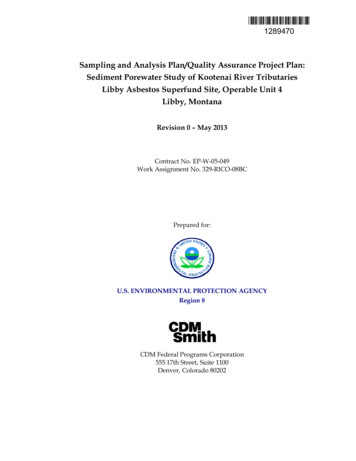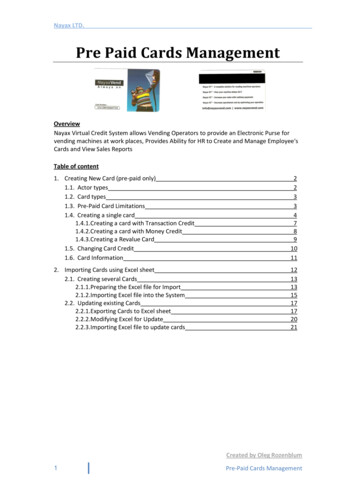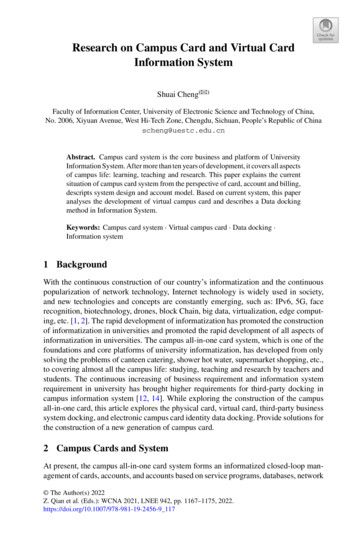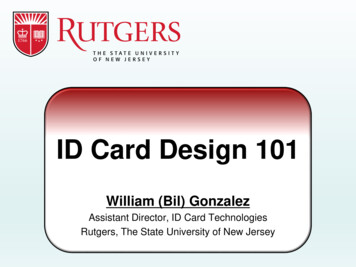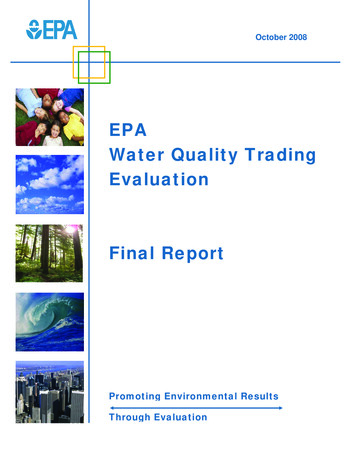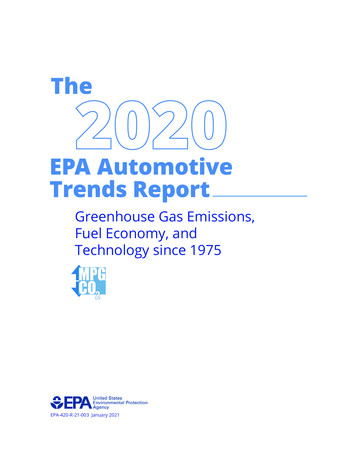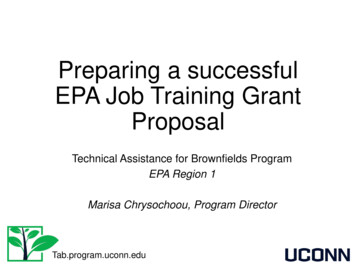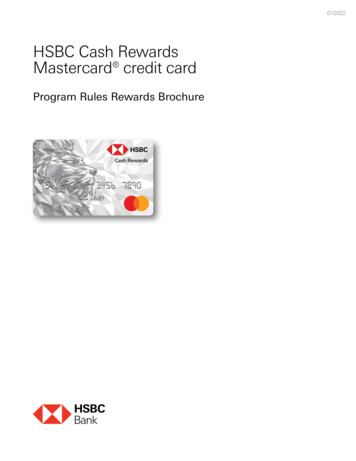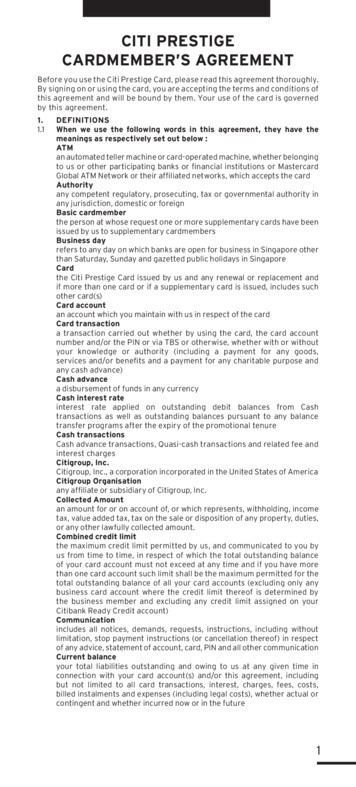
Transcription
U.S. ENVIRONMENTAL PROTECTION AGENCYOFFICE OF INSPECTOR GENERALOperating efficiently and effectivelyEPA’s Purchase Card andConvenience CheckProgram Controls Are NotEffective for PreventingImproper PurchasesReport No. 18-P-0232August 20, 2018
Report Contributors:Eileen CollinsMadeline MullenMichael PetscavageAlexandra PNETCouncil of the Inspectors General on Integrity and EfficiencyU.S. Environmental Protection AgencyFiscal YearGenerally Accepted Government Auditing StandardsU.S. Government Accountability OfficeOffice of Inspector GeneralOffice of Management and BudgetPaymentNet Cover Images: Computer, photographic and laboratory accessories are typical itemsbought with EPA purchase cards and convenience checks.(General Services Administration, EPA and EPA OIG images)Are you aware of fraud, waste or abuse in anEPA program?EPA Inspector General Hotline1200 Pennsylvania Avenue, NW (2431T)Washington, DC 20460(888) 546-8740(202) 566-2599 (fax)OIG Hotline@epa.govLearn more about our OIG Hotline.EPA Office of Inspector General1200 Pennsylvania Avenue, NW (2410T)Washington, DC 20460(202) 566-2391www.epa.gov/oigSubscribe to our Email UpdatesFollow us on Twitter @EPAoigSend us your Project Suggestions
U.S. Environmental Protection AgencyOffice of Inspector General18-P-0232August 20, 2018At a GlanceWhy We Did This ProjectThe U.S. EnvironmentalProtection Agency’s (EPA’s)Office of Inspector (OIG)conducted this audit after a riskassessment determined thatthe risk was high enough towarrant an audit.Our objective was to determinewhether EPA internal controlsover its purchase card andconvenience check programare adequate to prevent anddetect material illegal, improperand erroneous purchases.This report addresses thefollowing: Operating efficiently andeffectively.EPA’s Purchase Card and Convenience CheckProgram Controls Are Not Effective for PreventingImproper PurchasesWhat We FoundEPA internal controls were not effective. Cardholders,approving officials, the purchase card team, and EPAprogram offices were not providing oversight neededto achieve compliance with internal controls. Althoughcardholders and approving officials must ensure thateach purchase request complies with federal andagency acquisition and appropriation rules, in mosttransactions, they did not.Ineffective oversightat the EPA contributedto improper purchasestotaling 57,017 fromsampled transactions.Recommendations and Planned Agency Corrective ActionsWe made a total of 11 recommendations, including 10 to the AssistantAdministrator for Administration and Resources Management and one tothe Deputy Administrator.Highlights from the 10 recommendations to the Assistant Administrator forAdministration and Resources Management include requests for the agencyto (1) conduct an assessment and determine how to enhance controls, reduceconfusion and achieve compliance; (2) determine whether adding languageabout cardholder and approving official responsibilities to performance standardswould be beneficial and improve compliance; (3) implement preventive controlsthat would stop transactions that do not have required approvals or funding;(4) fully implement and increase the use of detective controls; and (5) issueguidance regarding penalties for noncompliance and the process for suspendingcardholder privileges due to noncompliance.One recommendation requested that the EPA Deputy Administrator issue anagencywide memorandum to emphasize compliance with federal and EPArequirements for purchase card and convenience check transactions.The EPA agreed to take corrective actions on all 11 recommendations andprovided planned completion dates. The agency’s planned corrective actions andcompletion dates meet the intent of the recommendations. All recommendationsare resolved with corrective actions pending.Send all inquiries to our publicaffairs office at (202) 566-2391or visit www.epa.gov/oig.Listing of OIG reports.
UNITED STATES ENVIRONMENTAL PROTECTION AGENCYWASHINGTON, D.C. 20460THE INSPECTOR GENERALAugust 20, 2018MEMORANDUMSUBJECT:EPA’s Purchase Card and Convenience Check Program ControlsAre Not Effective for Preventing Improper PurchasesReport No. 18-P-0232FROM:Arthur A. Elkins Jr.TO:Henry Darwin, Acting Deputy AdministratorDonna Vizian, Principal Deputy Assistant AdministratorOffice of Administration and Resources ManagementThis is our report on the subject audit conducted by the Office of Inspector General (OIG) of theU.S. Environmental Protection Agency (EPA). The project number for this audit was OA-FY18-0045.This report contains findings that describe the problems the OIG has identified and corrective actions theOIG recommends. This report represents the opinion of the OIG and does not necessarily represent thefinal EPA position. Final determinations on matters in this report will be made by EPA managers inaccordance with established audit resolution procedures.The Office of the Administrator is responsible for all offices within the EPA, including programoffices that handle purchase card and convenience check transactions. The Office of AcquisitionManagement within the EPA’s Office of Administration and Resources Management is responsible forimplementing and overseeing the agency’s purchase card and convenience check program.In accordance with EPA Manual 2750, your office provided acceptable corrective actions and milestonedates in response to OIG recommendations. All recommendations are resolved and no final response tothis report is required. However, if you submit a response, it will be posted on the OIG’s website, alongwith our memorandum commenting on your response. Your response should be provided as an AdobePDF file that complies with the accessibility requirements of Section 508 of the Rehabilitation Act of1973, as amended. The final response should not contain data that you do not want to be released to thepublic; if your response contains such data, you should identify the data for redaction or removal alongwith corresponding justification.We will post this report to our website at www.epa.gov/oig.
EPA’s Purchase Card and ConvenienceCheck Program Controls Are Not Effectivefor Preventing Improper Purchases18-P-0232Table of ContentsPurpose.1Background .1Responsible Offices .2Scope and Methodology .2Results .4Purchase Card Users Must Comply with Federal and EPA Requirements .EPA Internal Controls Were Not Effective .EPA Has Not Implemented Proactive Controls .Ineffective Oversight Increases Risk and Results in Improper Purchases.4578Conclusion .9Recommendations .10Agency Comments and OIG Evaluation .11Status of Recommendations and Potential Monetary Benefits .14AppendicesAAgency Response to Draft Report.15BDistribution .24
PurposeOur objective was to determine whether U.S. Environmental Protection Agency(EPA) internal controls over its purchase card and convenience check program areadequate to prevent and detect material illegal, improper and erroneouspurchases.BackgroundThe Government Charge Card Abuse Prevention Act of 2012 states the followingabout Inspector General responsibilities:The Inspector General of each executive agency shall—(1) conductperiodic assessments of the agency purchase card or conveniencecheck programs to identify and analyze risks of illegal, improper,or erroneous purchases and payments in order to develop a plan forusing such risk assessments to determine the scope, frequency, andnumber of periodic audits of purchase card or convenience checktransactions.Office of Management and Budget Memorandum M-13-21 determined that, at aminimum, periodic risk assessments are to be performed on an annual basis.The EPA’s Office of Inspector General (OIG) issued EPA OIG Report No.14-P-0128, Ineffective Oversight of Purchase Cards Results in InappropriatePurchases at EPA, on March 4, 2014. That report was the OIG’s first purchasecard report. Of 152,602 in sampled transactions, 79,254 were prohibited,improper or erroneous purchases. Prohibited purchases included meals for anawards-recognition ceremony, and gym memberships for EPA employees andtheir families. The EPA reported that corrective actions for all sevenrecommendations were complete as of December 10, 2014.On December 20, 2016, we notified the EPA that we would participate in aCouncil of the Inspectors General on Integrity and Efficiency (CIGIE) purchasecard cross-cutting project led by the U.S. Department of Agriculture OIG. TheEPA OIG examined purchase card transactions for the first two quarters of fiscalyear (FY) 2017. Those results will be consolidated into a CIGIE report on thegovernment purchase card initiative.EPA OIG Report No. 17-P-0113, Risk for EPA’s Fiscal Year 2016 Purchase Cardand Convenience Check Program Warrants an Audit, was issued February 14,2017. In that report, we assessed the risk for the EPA’s purchase card andconvenience check program was high enough to warrant an audit because ofnoncompliance with existing controls. On October 11, 2017, we notified the EPAthat we were beginning the audit.18-P-02321
Responsible OfficesThe Office of the Administrator is responsible for all offices within the EPA,including program offices that handle purchase card and convenience checktransactions. The Office of Acquisition Management within the EPA’s Office ofAdministration and Resources Management is responsible for implementing andoverseeing the agency’s purchase card and convenience check program. However,the Office of Acquisition Management does not supervise staff responsible forpurchase card or convenience check transactions within EPA program offices.Scope and MethodologyWe conducted this audit from November 2017 through June 2018, in accordancewith generally accepted government auditing standards (GAGAS), except forindependence standards regarding two of the 75 EPA OIG transactions. Thosestandards require that we plan and perform the audit to obtain sufficient,appropriate evidence to provide a reasonable basis for our findings and conclusionsbased on our objectives. We believe that the evidence obtained provides areasonable basis for our findings and conclusions based on our objective.For two of the 75 EPA OIG transactions, we used the GAGAS “conceptualframework” to identify and evaluate threats to independence, and to applysafeguards to reduce the threats to an acceptable level. The “conceptualframework” assists auditors in maintaining independence of mind and inappearance. We cited noncompliances in each of the two OIG transactions, andnon-purchase cardholders completed the audit work.The EPA reported 80,917 purchase card transactions and 458 convenience checktransactions totaling 41,175,877 and 241,078, respectively, in FY 2017. Thesepurchases were made by 1,145 different purchase cardholders and conveniencecheck account holders. To answer our objective, we reviewed the followinginformation that includes the applicable law; requirements established by theU.S. Government Accountability Office (GAO) and the Office of Managementand Budget (OMB); and EPA policy and procedures: 18-P-0232Government Charge Card Abuse Prevention Act of 2012.Standards for Internal Control in the Federal Government,GAO-14-704G, September 2014.Management’s Responsibility for Enterprise Risk Management andInternal Control, OMB Circular A-123, July 15, 2016.Improving the Management of Government Charge Card Programs, OMBCircular A-123, Appendix B, January 15, 2009.EPA Acquisition Guide, Section 13.3.1, Using the Government-wideCommercial Purchase Card, December 2015.The EPA’s Agency-Wide Purchase Card Standard Operating ProceduresPayment Net (PNET) Purchase Card Automation Process.2
The EPA OIG also participated in the CIGIE cross-cutting project to analyzegovernment purchase card transactions. We determined that the CIGIEtransactions and methodology should be incorporated into our audit of theEPA’s purchase card and convenience check program.The CIGIE information technology committee had created weighted algorithms todetermine high-risk transactions. According to CIGIE methodology, the followingcategories of transactions merited closer review: Prohibited Merchant Category Codes.Questionable Merchant Category Codes.Cardholder Exceeded Single-Purchase Limit.Split Transaction.Sales Tax Transaction.Holiday Transaction.Weekend Transaction.Unauthorized Third-Party Merchants.Closed Account Activity.We used these algorithms to identify 23 sample purchase card transactions foreach of the first three quarters of FY 2017.In addition, we judgmentally selected a sample of six convenience checktransactions for review, each of which was 2,000 or above. As a result, the totalsample was 75 transactions involving 70 cardholders and 67 approving officials,as shown in Table 1. The value of all sampled transactions was 58,128.26.Table 1: EPA transactions sampledTransaction typePurchase cardConvenience checkTotal1st Qtr.FY 20172322nd Qtr.FY 20172323rd Qtr.FY 2017232Total69675Source: OIG samples.Each transaction was reviewed for compliance with 16 EPA policy and procedurerequirements.We interviewed staff within the Office of Acquisition Management and obtaineddocuments from PaymentNet (PNET), the EPA’s acquisition system, andcardholder files. After reviewing sampled transaction documents, we emailed andinterviewed cardholders and approving officials as needed. We also followed upon the March 2014 EPA OIG audit recommendations for EPA purchase cards.18-P-02323
ResultsPurchase Card Users Must Comply with Federal and EPARequirementsRelevant law, policy, procedures andguidance include the following: The Government Charge CardAbuse Prevention Act of 2012requires executive agencies to use“effective systems, techniques andtechnologies to prevent or identifyillegal, improper or erroneouspurchases.” The act also requiresagencies to have policies about thenumber of purchase cards.A computer hard drive is a typical item boughtthrough one of the sampled purchase cardtransactions. (EPA OIG photo)Standards for Internal Control inthe Federal Government, GAO-14-704G, September 2014, states that:o Management should use quality information to achieve objectivesand address risks.o Management should identify and respond to risks for achievingobjectives.18-P-0232 Management’s Responsibility for Enterprise Risk Management andInternal Control, OMB Circular A-123, July 15, 2016, notes that it ismanagement’s responsibility to continuously monitor, assess and improveinternal control effectiveness. Further, management should identify andcorrect control deficiencies. Improving the Management of Government Charge Card Programs, OMBCircular A-123, Appendix B, January 15, 2009, prescribes policies andprocedures for internal controls to reduce government charge card risks offraud, waste and error. The EPA Acquisition Guide, Section 13.3.1, Using the Government-wideCommercial Purchase Card, December 2015, establishes policy for usinggovernmentwide commercial purchase cards at the EPA. The guidelinesdetail requirements for approvals, special approvals, closer scrutiny,mandatory sources and strategic sourcing. The EPA’s Agency-Wide Purchase Card Standard Operating ProceduresPayment Net (PNET) Purchase Card Automation Process states thateffective August 1, 2015, all purchase card transactions are required4
to be documented in PNET. Failure to document transactions in PNETresults in suspension of purchase card privileges until PNET is updated.EPA Internal Controls Were Not EffectiveAlthough the EPA implemented numerous internal controls for its purchase cardand convenience check program in response to the 2014 EPA OIG audit report,we found that the agency’s internal controls were not effective to prevent anddetect material illegal, improper or erroneous purchases. Cardholders, approvingofficials, the purchase card team, and program offices were not providingoversight needed to achieve compliance with internal controls.Although cardholders must ensure that each purchase request complies withfederal and agency acquisition and appropriation rules, in most transactions, theydid not. Approving officials are responsible for ensuring compliance with allapplicable regulations, policies, procedures and special approvals; however, theyoften did not. Table 2 notes that each of the 69 purchase card and six conveniencecheck transactions sampled had at least one noncompliance.Table 2: Tested transactionsTypeCompliantPurchase cards0Convenience checks0Noncompliant696Source: OIG analysis of tested transactions.Purchase Card NoncompliancesNumerous noncompliances were noted for each of the FY 2017 quarterstested. Some transactions did not comply with multiple requirements, asnoted in Table 3.Table 3: Purchase card noncompliances for 69 transactions1st Qtr. 2nd Qtr. 3rd Qtr.No.Internal control issuesFY 2017 FY 2017 FY 2017 Total1Not approved by approving official in17191551PNET by the 28th of the month.2All supporting documentation not in15161243PNET as required.3Missing justification for not using891027mandatory sources.4Missing third-party verification for6101026goods received.5Missing required purchase log.10882667818-P-0232Missing/inadequate approving officialapproval prior to purchase.Purchases were not declined forblocked merchant category codes.Third-party payment processingprocedures were not followed.6792275820735155
No.91011Internal control issuesFund availability was not verified priorto placing the order.Sales taxes paid without justification.Other (one or fewer instances perquarter).1st Qtr. 2nd Qtr. 3rd Qtr.FY 2017 FY 2017 FY 2017 Total5711323031238Source: OIG analysis of tested transactions (23 per quarter).The following transactions illustrate a variety of noncompliances: 1,100 transaction to purchase a wireless projector. The cardholderdid not obtain information technology approval for the purchase, didnot justify why mandatory sources were not used, did not documentthat funds were available, did not obtain third-party verification fromthe property utilization officer, and the approving official did notapprove the transaction in PNET by the 28th of the month. 1,347 transaction to purchase computer memory. The cardholderdid not maintain all supporting documentation in PNET, did notdocument justification for not using mandatory sources, paid salestaxes on items purchased and did not document a justification forpaying the sales tax, and did not create and maintain a purchase login PNET. In addition, the approving official did not approve thetransaction in PNET by the 28th of the month. 3,125 transaction to purchase laboratory chemicals. Thecardholder not obtain approval from the approving official prior toplacing the order and did not consolidate two similar transactions thatexceeded the single-purchase limit. 1,442 transaction to purchase editing services. Although restrictedto an acquisition professional, the cardholder—not an acquisitionprofessional—did not comply with mandatory verification steps forvendors using third-party payment processing services. In addition, theapproving official did not approve the transaction in PNET by the 28thof the month.Convenience Check NoncompliancesThe six convenience check transactions that we reviewed had similarnoncompliance issues. For example, in three transactions, funding availabilitywas not verified prior to the cardholder’s involvement. Table 4 notes that infour transactions, not all of the supporting documentation was placed in PNETas required.18-P-02326
Table 4: Convenience check noncompliances for six transactions1st Qtr. 2nd Qtr. 3rd Qtr.No.Internal control issuesFY 2017 FY 2017 FY 2017 Total1Missing approval from an approving official1225prior to purchase.2Not approved by approving official in PNET2215by the 28th of the month.3All supporting documentation not in PNET2114as required.4Fund availability not verified prior to placing1023the order.5Restricted transaction requiring an0022acquisition professional.6Missing third-party verification for goods0101received.7Tax identification not obtained at time of0101purchase.8Missing required purchase log.01019Unable to determine whether training officer0011approval was provided.10Unable to determine total price of purchase.0011Source: OIG analysis of tested transactions (two per quarter).In the case of a 2,000 training transaction,the dates of purchase, funding and trainingapproval were unknown. Also, it was arestricted transaction that should have beenmade by an acquisition professional, and theapproving official approved the transactionlate in PNET.EPA Has Not Implemented ProactiveControlsComputer accessories like this dockingstation are typical items obtained throughone of the sampled purchase cardtransactions. (EPA OIG photo)Despite the EPA’s control efforts, oversightis weak. The purchase card team, which isresponsible for administering the EPApurchase card program, does not have enough staff to implement effectiveproactive and detective controls. Instances of cardholder noncompliance primarilyresulted from ineffective training and/or a lack of monitoring and controlactivities. Also, the EPA does not have a specific policy to address the appropriatenumber of cardholders needed to make purchases in compliance with EPA policyand procedures.The following transactions note specific causes of noncompliance related to thepurchased goods and services.18-P-02327
Goods Computer keyboards. The cardholder did not know that documentinga justification for not using mandatory sources is required.Laboratory supplies. The cardholder did not know that the vendorused a third-party payment processing service when the order wasplaced.Laboratory supplies. The approving official did not think that PNETwas required and did not know about its relevance to the EPA.Remote garage door opener. The cardholder was not aware thatdocumenting a justification for not using a mandatory source isrequired.ServicesIn one training course transaction, the approving official did not approve thetransaction in PNET because the official did not know approval was requiredby the 28th of the month. In another training course transaction, the cardholderwas unaware of the mandatory steps for vendors using third-party paymentprocessing services, including the process for purchase orders. A thirdexample involved a training course where the cardholder did not validate thetransaction in PNET to notify the approving official of the need to review andapprove. A fourth example involved a training course and a conveniencecheck holder who was only involved at the end of the process.Ineffective Oversight Increases Risk and Results in ImproperPurchasesIneffective oversight contributes to risks of illegal, improper and erroneouspurchases. Even though the OIG did not identify any fraudulent or illegaltransactions, all sampled transactions were noncompliant with at least one internalcontrol. Also, none of the 75 reviewed transactions were in complete compliancewith EPA requirements. The totalsample value was 58,128, of which 57,017 represented impropertransactions.We defined improper transactions aspurchases that, although intended forgovernment use, were made contraryto and despite the EPA’s writtenpurchase guide and procedurerequirements. We did not include asimproper transactions, instanceswhere post-purchase administrative18-P-0232Computer keyboards are also common itemsobtained through one of the sampled purchasecard transactions. (EPA OIG photo)8
requirements (such as placing documents in PNET, starting a purchase log orobtaining third-party verification after the purchase) were not met. The followingexamples of noncompliance were deemed improper: Cardholder did not obtain pre-approval.Cardholder did not obtain funding in advance.Cardholder did not use mandatory or strategic sources.Cardholder did not follow steps for third-party processors.Cardholder split transactions that would have exceeded the micropurchase level.Purchase was not made by an acquisition professional cardholder asrequired.Special approval by an Information Management Officer was not obtainedfor information technology equipment purchases.Merchant Category Code blocking did not work.The total dollar amounts for improper purchase card and convenience checktransactions are found in Table 5.Table 5: Dollar value of improper purchases by quarterFY 2017Improper purchasequarteramounts1st Qtr. 16,858.372nd Qtr.18,315.773rd Qtr.21,843.22Total 57,017.36Source: OIG analysis of tested purchase card and conveniencecheck transactions.ConclusionIn response to our discussion document, theEPA agreed with and committed to severalactions summarized in the 11 recommendationsthat accompany this report.The EPA also completed several actions.The agency issued “Flash Notices” duringJanuary 2018 and April 2018 to cardholdersand approving officials to remind them thatthey are required to consider the availableEPA-mandated, strategic-sourcing contractsLaboratory supplies are typical items obtainedand mandatory sources. The agency providedthrough one of the sampled purchase cardtransactions. (EPA OIG photo)training on purchase card requirements to theOffice of Acquisition leadership in April 2018.In addition, the agency developed draft purchase cardtraining slides to address issues identified in this audit.18-P-02329
RecommendationsWe recommend that the Assistant Administrator for Administration andResources Management:1. Conduct an assessment and determine how to enhance controls, reduceconfusion and achieve compliance.2. Determine whether adding language about cardholder and approvingofficial responsibilities to performance standards would be beneficial andimprove compliance.3. Implement preventive controls that would stop transactions that do nothave required approvals or funding.4. Fully implement and increase the use of detective controls, such as regulartransaction reviews for purchase card and convenience check compliance.5. Issue guidance regarding penalties for noncompliance and the process forsuspending cardholder privileges due to noncompliance.6. Revise guidance for strategic and mandatory sources to provide a simpleroad map for programs, cardholders and approving officials.7. Enforce the requirement for convenience check account holders and theirapproving officials to be involved in convenience check transactions fromthe beginning of the order process.8. Provide detailed training on EPA purchase card guidance, policy andexpectations to cardholders and approving officials.9. Take steps to rectify purchases made without prior funding approval.10. Implement a policy regarding the appropriate number and categories ofpurchase cardholders.We recommend that the Deputy Administrator:11. Issue an agencywide memorandum to emphasize compliance with federaland EPA requirements for purchase card and convenience checktransactions.18-P-023210
Agency Comments and OIG EvaluationIn its response to our draft report, the EPA concurred with all 11recommendations and provided acceptable high-level corrective actions withestimated completion dates.In response to Recommendation 1, which recommended that the EPA conduct anassessment and determine how to enhance controls, the Office of Administrationand Resources Management will establish a work group to conduct an assessmentand brainstorm how to enhance controls, reduce confusion and achieve compliance.Within the same timeframe, the EPA will issue a memorandum to resource officialsrequiring them to enhance controls and achieve compliance. The agency’s responsemeets the intent of Recommendation 1.For Recommendation 2, we recommended that the EPA determine whether itwould be beneficial to add language about cardholder and approving officialresponsibilities to performance standards. The EPA referred to existing EPAAcquisition Guide language to include purchase card responsibilities inperformance appraisals. The EPA stated that within 30 days of the response, theagency’s purchase card team will issue a reminder E-Blast notice regarding theexisting EPA Acquisition Guide language. The agency’s response meets the intentof Recommendation 2.In response to Recommendation 3, which recommended that the EPA implementpreventive controls, the EPA stated that the agency will address corrective actionsthrough the work group formed in response to Recommendation 1. With theOffice of Administration and Resources Management’s work group assessment,and the implementation of preventive controls that will stop transactions fromoccurring without required approvals or funding, the planned corrective actionsmeet the intent of the Recommendation 3.For Recommendations 1, 2 and 3, the EPA provided an estimated completion dateof October 5, 2018.In response to Recommendation 4, which recommended that the EPA implemen
and Convenience Check Program Warrants an Audit, was issued February 14, 2017. In that report, we assessed the risk for the EPA's purchase card and convenience check program was high enough to warrant an audit because of noncompliance with existing controls. On October 11, 2017, we notified the EPA that we were beginning the audit.
